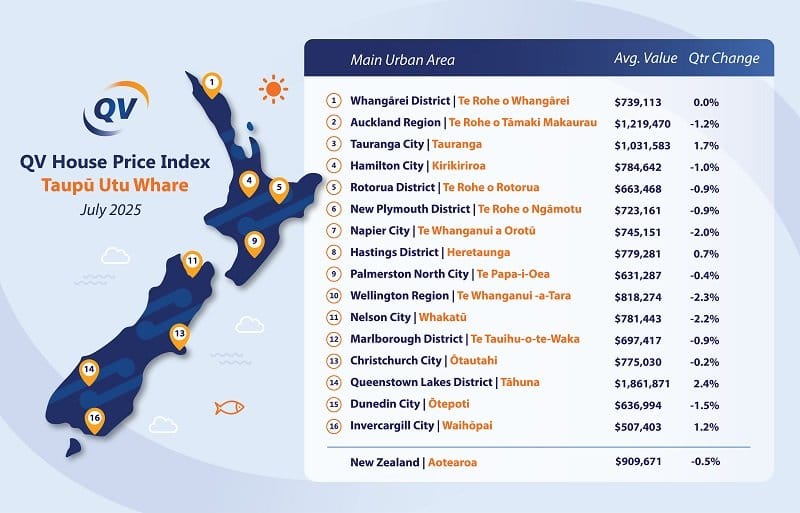
The latest QV House Price Index shows average home values across New Zealand dipped by 0.5% over the three months to the end of July, with the national average now $909,671. Values remain almost unchanged compared to the same time last year, and the nationwide average value is 13.1% below the market peak in January 2022 of $1,047,132.

While the rate of decline has slowed in many areas, the overall market remains subdued. Values were down in most of the main centres this quarter, including Auckland (-1.2%), Wellington (-2.3%), Hamilton (-1.0%), and Dunedin (-1.5%). However, some cities bucked the trend with value growth over the past three months, such as Tauranga (1.7%), Queenstown (2.4%), and Invercargill (1.2%). Whangarei and Christchurch were largely flat.
QV National Spokesperson Andrea Rush said the housing market is still adjusting to a softer economic environment, with many buyers carefully weighing affordability, employment security, and mortgage servicing costs before committing to a purchase.
“There’s more activity occurring at the lower to mid-value end of the market, where first-home buyers and owner-occupiers remain the most engaged,” she said. “These buyers are being supported by relatively stable interest rates, improving access to finance, and a wide range of listings, particularly in larger urban centres.”
Rush said market conditions continue to vary by location and property type, with some regional centres experiencing renewed value growth off the back of earlier declines and ongoing demand for affordable housing.
“While national value levels have broadly stabilised, the recovery is uneven and fragile,” she said. “Vendors in many areas are having to meet the market to achieve a sale, while some buyers remain hesitant due to broader economic uncertainty.”
With the traditional spring uplift in listings just around the corner, Rush said the next few months will be pivotal in determining whether the market begins to tilt more decisively toward recovery.
Southland Bucking the Trend
The Southland region continues to see values increase more than many other parts of the country, buoyed by the primary sector and low entry to the residential property market. Values rose 1.3% over the quarter to an average value of $505,467 and are up 4.7% year on year.
Invercargill values rose 1.2% over the three months to July, with the average home now valued at $507,403 — up 5.0% year on year and 5.5% above the nationwide market peak.
Gore District recorded a quarterly increase of 5.6%, with the average home value now sitting at $442,299, up 7.8% annually.
Meanwhile, Southland District values declined 0.3% this quarter to $533,831, though they remain 2.7% higher than at the same time last year.
QV Invercargill Registered Valuer Andrew Ronald said the Southland property market remains active, particularly at the lower to mid end of the market where demand from first-home buyers remains strong — especially in the $350,000 to $500,000 price bracket.
“Investor interest is continuing to lift, supported by earlier rental growth, although that has now started to stabilise,” he said.
Mr Ronald noted that listings remain tight, which is helping to support values in Invercargill and Gore.
“Confidence in the market is underpinned by the strength of the primary sector, and Gore’s recent value growth reflects that ongoing regional resilience.”
“Meanwhile, demand for properties priced above $1 million remains limited, with buyer caution still evident at the top end of the market,” he said.
Local Industry Voices
Jacqui van Dam, Licensee Salesperson at Ray White Invercargill, said:
“Traditionally, the winter months bring a quieter period for both listings and sales, yet this year we’re holding our ground well. It’s becoming increasingly noticeable that the higher cost of living further north is driving more people south, particularly for study at SIT and the opportunity to enter the housing market at a more affordable level. The $400,000–$500,000 price bracket remains very active, though listings in this range are limited. With spring approaching quickly, we anticipate a seasonal lift in listings, which should generate increased activity across the board.”
Mandy Jordan from Mortgage & Insurance Supply Southland agreed with Ronald’s comments, confirming that supply and demand pressures are contributing to the price increases.
“Listing numbers are down, and pre-approved clients are up which is great for home values in Southland. We’re about to enter spring which historically means lender specials and competition in the lead up to Christmas which should stimulate the buyers further. Clients feel excited and positive — it’s a great place to be.”

